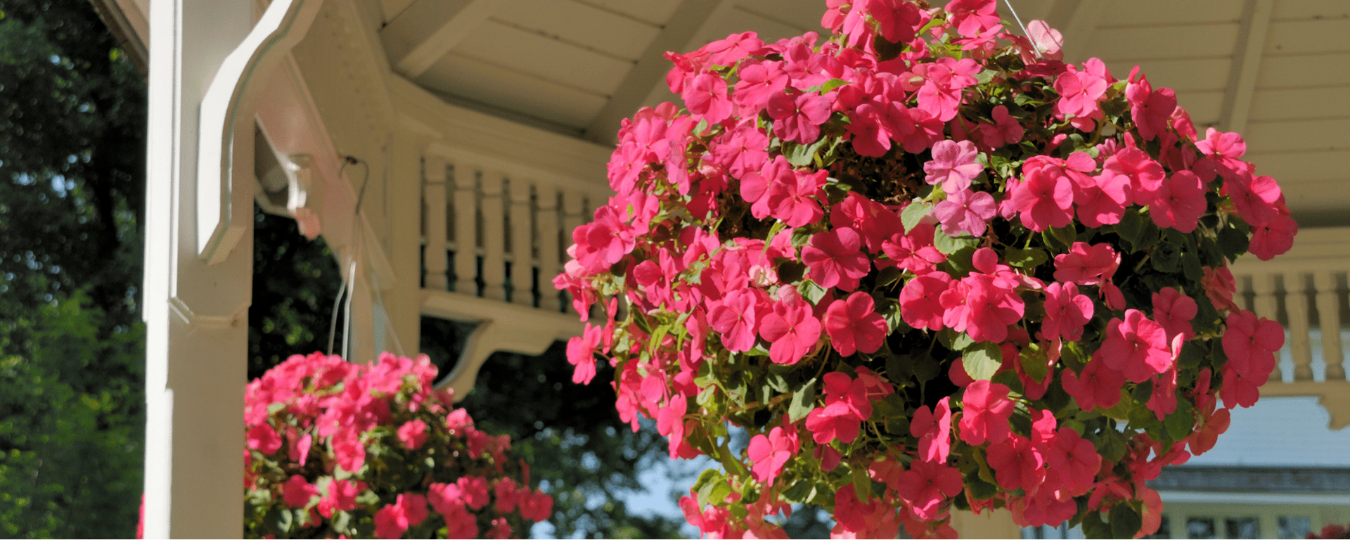Hanging Baskets - A Beginner's Guide

Hanging baskets cheer up your home with colour and pretty blooms while adding dimension to your garden. Creating beautiful hanging baskets is easy when you know how, so we’ve created this ultimate guide to help you along.
Choosing a Style
Before gathering everything you need, try to have an idea in mind of the finished look you’re going for. There’s plenty of choice when selecting the basket itself and the plants to go in it, so you might want to choose a colour scheme and style before going shopping. Pinterest.com is a great site for inspiration, just search “hanging baskets”. For example, you might decide to just have rich green foliage tumbling down for length, or you might prefer a big voluminous ball of colour with fuchsia and geraniums.
What You Need for Your Hanging Baskets
The Basket
The most popular type of hanging basket in Ireland is a wire basket, but there are also solid-sided plastic and wicker baskets, all available in a variety of sizes. Choosing a type is a matter of visual preference, although woven wicker baskets will be less durable in Irish weather. Size wise, bigger means less maintenance. If a basket is small in proportion to the plants, it will need more watering and pruning. Go for a larger size where possible, about 14-16 inches; it will retain water better, provide more rooting space and nutrient-rich compost, and allow your plants the room to grow and bloom fully.
The Liner
The lining for your basket is the more important choice as it plays an important role in creating the optimal environment for your plants. The right liner will provide the perfect balance between drainage and water retention. The most common and affordable is the cocoa liner, which is a thick, pre-moulded liner made from natural fibres. It holds water well with good drainage and aeration. Sphagnum moss is an alternative that works and looks well, but is difficult to work with. Burlap is another low price and environmentally friendly liner choice, but it does not retain water. And finally, Supamoss, which is probably the most versatile liner. It holds water with sufficient drainage, it’s flexible and looks natural. If you’re using a wicker basket that comes with its own plastic liner, you may need to punch some holes in the plastic to allow for drainage.
The Compost
The next ingredient for your perfect hanging basket is compost. The ideal compost to use is a peat-free, multi-purpose compost, to which you can add controlled-release food granules and water retention gel for best results.
The Plants
Sweet pea, lobelia, petunia, begonia, fuchsia and pansies, provide colourful blossoms and thrive in hanging baskets. Dichondra (kidney weed), cineraria silver dust and yucca are great choices for foliage. Your choice of plants should however, depend on the time of year…
Hanging Baskets for All Seasons
Common practice is to plant your hanging baskets in early spring in a greenhouse, and to put them outside once the risk of frost has passed, however there is no reason why you can’t plant winter plants in your hanging baskets to give your home and garden a lift through the duller months. Just remember not to water your hanging baskets as much in autumn and winter.
You can then swap out plants as the seasons change and it refreshes your home’s exterior each time.
Here is our list of the top hanging basket plants for each season:
- Spring: pansies, dwarf bulbs (daffodils, tulips, narcissus), lobelia.
- Summer: fuchsia, yucca, geranium, petunia.
- Autumn: viola ochre, cineraria silver dust, mini cyclamen.
- Winter: solanum plants, winter pansies, dwarf conifers, heather, ivy, primula.


Leave a Comment